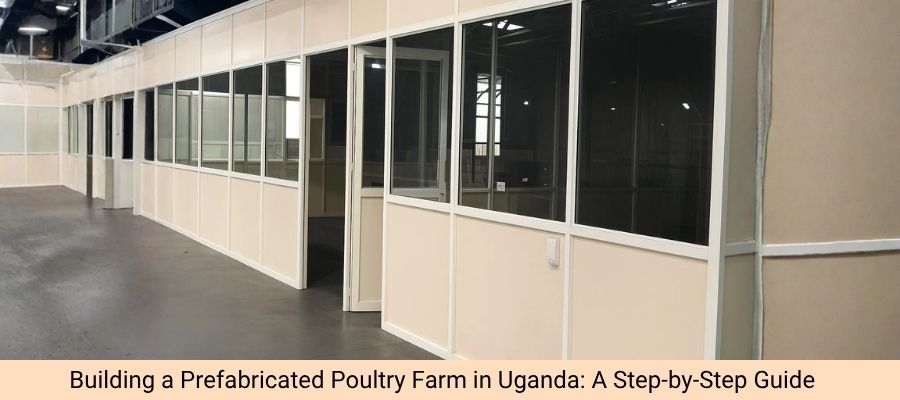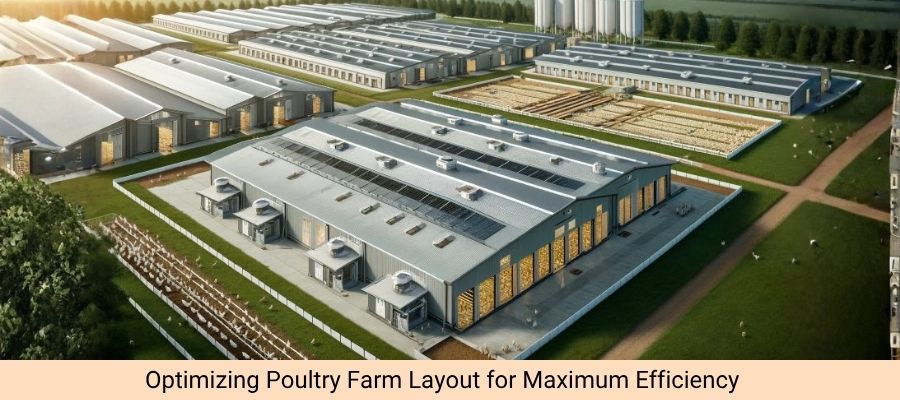Prefabricated Poultry Farm in Uganda: Step-by-Step Building Guide

Objective of the Article:
The aim of this article is to provide a comprehensive and practical roadmap for entrepreneurs, farmers, and agribusiness investors interested in setting up a modern poultry farm in Uganda using prefabricated technology.
By outlining the key steps involved—from site selection and designing the layout to choosing materials, construction, and post-construction maintenance—the article aims to:
- Guide prospective poultry farm owners in understanding the key requirements of building an efficient and scalable poultry farm, tailored to Uganda’s specific agricultural environment.
- Highlight the benefits of using prefabricated structures in poultry farming, including cost-efficiency, rapid construction, and durability, particularly in Uganda’s climate.
- Provide insights into critical farm components such as water supply, feed management, ventilation, and waste disposal, ensuring proper farm setup for long-term sustainability and productivity.
- Ensure that entrepreneurs are well-prepared to meet regulatory requirements, maintain biosecurity, and optimize farm operations for maximum efficiency and profitability.
- Facilitate informed decision-making regarding the choice of materials, technology, and construction methods, promoting the use of modern, automated systems for improving poultry health, farm management, and overall productivity.
Ultimately, this article aims to empower Ugandan agribusinesses to adopt innovative, sustainable farming solutions that contribute to the growth of the country’s poultry industry while maximizing both operational and economic outcomes.
The poultry industry in Uganda has witnessed significant growth in recent years, with increasing demand for broilers, layers, and breeders to meet local consumption and export needs. Entrepreneurs, farmers, and agribusiness investors interested in starting a poultry farm can benefit from prefabricated farm structures, which offer cost-effective, scalable, and durable solutions.
This guide provides a comprehensive roadmap for building a modern poultry farm using prefabricated technology in Uganda. It covers the critical steps in planning, site selection, design, construction, and post-construction maintenance to ensure that your poultry farm is efficient, sustainable, and profitable.
Understanding Poultry Farming Needs and Market Opportunities in Uganda
Uganda’s poultry industry has become a vital part of its agricultural sector, driven by rising consumer demand for chicken meat and eggs. With a population of over 45 million people, Uganda’s consumption of poultry products continues to increase, creating a significant market for farmers. Additionally, Uganda’s strategic location in East Africa positions it as a potential exporter of poultry products to neighboring countries.
Before starting a poultry farm, it’s important to consider the type of poultry farming that aligns with your goals and resources:
Types of Poultry Farms
- Broiler Farms: Focused on raising chickens for meat production. The cycle lasts between 6 to 8 weeks.
- Layer Farms: These farms focus on egg production and require more long-term investment, as hens can lay eggs for up to 18 months.
- Breeder Farms: Used for producing hatching eggs to supply broiler and layer farms.
Estimating Capacity and Scalability
The next crucial step is determining the farm’s capacity, which will depend on the type of poultry farm and your production goals. Consider factors such as:
- Number of birds to be raised
- Expansion potential for future growth
- Land area and space required per bird (typically 1 to 2 square feet per bird)
Establishing your goals in terms of production capacity will also guide the layout and structure requirements for your prefabricated poultry farm.
Selecting the Right Site for a Poultry Farm in Uganda
The site you choose for your poultry farm in Uganda will play a critical role in its success. Several factors need to be considered:
Land Size and Location
The land size for your poultry farm will depend on the type of farming and the number of birds you plan to raise. Ideally, your farm should be in an area with easy access to transportation, close to residential zones for labor but far enough to avoid pollution and noise. Ensure that the site is accessible for delivery of feed, water, and other essential services.
Elevation and Drainage
It is essential to consider the elevation and drainage of the land. The site should not be prone to flooding, and it should be well-drained to avoid waterlogging. Soil strength is also vital to ensure the stability of the prefabricated structures.
Water, Electricity, and Feed Supply Access
The proximity to reliable water sources and electricity supply is crucial. Ensure your site has access to good-quality water for the birds, preferably with a continuous supply. Additionally, check for nearby sources of feed or transportation routes for easy delivery.
Compliance with Local Regulations
Before purchasing the land, check the local agricultural and environmental regulations. Make sure the farm complies with zoning laws, waste disposal regulations, and animal health codes.

Designing the Poultry Farm Layout for Maximum Efficiency
Effective space planning is essential for ensuring smooth operation, biosecurity, and efficient management of your poultry farm. The layout should include clearly defined zones for various activities:
Space Planning
- Housing Units: Each poultry shed should be designed to accommodate the appropriate number of birds. For broilers, each bird needs about 1.5 square feet of space, while layers need approximately 2 square feet per bird.
- Feed Storage: Designate an area for storing feed that is cool, dry, and pest-free to ensure feed quality.
- Waste Areas: Include areas for waste segregation and storage. This space should be positioned away from bird housing to reduce the risk of contamination.
- Office Units: Depending on the scale of the operation, a small office for farm management and operations is necessary.
Orientation for Natural Light and Airflow
Position your poultry sheds to take advantage of natural light and airflow. Proper orientation helps reduce energy costs and supports the health of the birds by ensuring adequate ventilation. You should also ensure that the structures are well-shaded to avoid heat stress, especially in Uganda’s tropical climate.
Zoning Areas for Biosecurity and Maintenance
Design the farm layout to separate clean areas from dirty areas (e.g., waste disposal, manure handling), and ensure easy access for cleaning and maintenance. This zoning helps improve biosecurity, ensuring that diseases and pests do not spread between different areas of the farm.
Choosing the Right Prefabricated Building Materials and Technology
Prefabricated poultry farms are increasingly popular in Uganda due to their quick construction times, cost efficiency, and adaptability to the climate. The choice of materials will directly impact the durability and energy efficiency of the farm.
Common Materials
- Galvanized Steel: A preferred material for the structural framework due to its strength and resistance to corrosion.
- Sandwich Panels: These panels are insulated and offer excellent thermal control, keeping the poultry sheds cool during hot weather and warm during cooler nights.
- Anti-Corrosive Coatings: Coating materials like zinc or polymer coatings for steel will extend the lifespan of the structures, especially in areas with high humidity or occasional rainfall.
Roof and Wall Insulation
Adequate roof and wall insulation is critical to ensure optimal temperature control in the sheds. This helps regulate the internal climate and minimizes the need for additional heating or cooling systems, reducing operational costs.
Benefits of Modular Steel Structures
Prefabricated modular steel structures offer several advantages for poultry farms, including:
- Durability: Prefabricated buildings are built to withstand harsh weather and frequent cleaning.
- Flexibility: Easy to modify and expand as your farm grows.
- Cost-Effective: Faster construction times and lower labor costs compared to traditional building methods.
Structural Design of Poultry Sheds: Strength, Safety & Space Optimization
The structural design of poultry sheds is critical for ensuring bird welfare, farm efficiency, and long-term durability.
Recommended Dimensions for Broiler and Layer Houses
- Broiler Houses: Typically need about 1.5 square feet per bird, with a shed height of 2.5 to 3 meters.
- Layer Houses: Require more space, approximately 2 square feet per bird, and should be 3 meters in height to allow for better air circulation and comfort.
Column Spacing, Truss Design, and Ventilation
Column spacing should be optimized to minimize material use while maintaining the shed’s structural integrity. Truss designs should allow for ample headroom and clear ventilation openings for natural airflow.
Flooring Options and Load-Bearing Considerations
Choose appropriate flooring materials such as concrete or slatted floors that allow waste to fall through while providing a stable surface for the birds. Ensure the foundation can bear the weight of the structure and withstand heavy rainfall or soil movement.
Ventilation, Lighting, and Temperature Control Systems
Effective ventilation and lighting are essential for poultry farm health and productivity. Proper temperature regulation helps prevent stress, ensuring optimal growth and egg production.
Natural vs. Mechanical Ventilation
While natural ventilation is ideal for prefab structures, in certain situations, mechanical ventilation may be necessary. Mechanical ventilation can be particularly useful during Uganda’s hot dry seasons, ensuring adequate airflow and reducing heat stress.
LED Lighting and Skylights
Use LED lighting systems to minimize electricity costs and promote the birds’ natural cycles. Skylights allow natural light to flood the sheds, reducing the need for artificial lighting during the day.
Humidity and Temperature Control
Maintain humidity levels between 50-70% and ensure that temperatures stay between 21-30°C to keep the birds comfortable. Using temperature monitoring systems can help manage and adjust the environment as needed.
Water Supply, Feed Management & Waste Disposal Planning
Proper water supply, feed management, and waste disposal systems are vital for a successful poultry farm.
Water Pipelines and Nipple Drinkers
Ensure that water pipelines are well-designed to provide continuous access to clean water. Install nipple drinkers to minimize water wastage and keep the birds hydrated.
Feed Silos and Distribution Systems
Design a feed silo system that can store large quantities of feed, and plan a feed distribution system to automatically deliver the right amount of feed to each bird.
Waste Segregation and Composting
Set up waste segregation systems to keep poultry litter separated and compost it for use as organic fertilizer. This will improve hygiene, reduce waste buildup, and create a secondary revenue stream.
Electrical, Plumbing, and Automation Integration
For a modern poultry farm, integrating electrical, plumbing, and automated systems is essential for optimizing operations.
Automated Feeding and Temperature Monitoring
Install automated feeding systems to ensure consistent feeding and reduce labor costs. Temperature sensors and alarm systems can alert you to any changes in the shed’s climate.
Backup Power Options
Install solar panels or generators as backup power options to ensure continuous operations during power outages, especially in remote areas.
Construction, Installation, and Quality Checks
Once the design and materials are finalized, the construction process begins. This typically includes off-site prefabrication followed by on-site assembly.
Quality Control Inspections
Ensure that quality checks are performed at each stage of construction, including verifying structural stability, insulation effectiveness, and ventilation efficiency.
Post-Construction Maintenance and Biosecurity Management
After construction, regular maintenance and biosecurity management are essential to keep the farm operational and disease-free.
Cleaning and Disinfection
Implement regular cleaning and disinfection protocols to maintain a hygienic environment for the birds.
Pest Control
Fencing and restricted access zones are essential for biosecurity. Regularly inspect for pests and rodents and take necessary action to control them.
Scheduled Maintenance
Scheduled inspections and preventive maintenance are essential for ensuring the longevity and functionality of the farm’s infrastructure.
Conclusion
Building a prefabricated poultry farm in Uganda is a rewarding venture for entrepreneurs and agribusiness investors. By following this step-by-step guide, you can ensure that your farm is efficient, scalable, and equipped with the latest technologies to meet market demands. With proper planning, the right materials, and a focus on biosecurity and maintenance, your poultry farm will be well-positioned for long-term success.

Founder & CEO
Mukesh Patel is the Founder & CEO of Build Matt ltd, specializing in Pre-Engineered Buildings (PEB) and general steel fabrication. With advanced technology, modern machinery, and a skilled workforce, he delivers efficient and high-quality solutions across East and Central Africa, including Uganda, Kenya, Tanzania, Congo, South Sudan, Rwanda, and Burundi.
- Steel Kiosk Manufacturing Key Differences in Mall, Banking, and Parking Applications
- Prefabricated Poultry Farm in Uganda: Step-by-Step Building Guide
- How Modern Warehousing Contractors Integrate Steel Structures with Digital Design in Uganda
- Steel Mezzanine Floor & Roof Structure Engineering for Large Warehouses by Contractors in Uganda
- The Growing Demand for Prefabricated Walkways in Uganda’s Various Industries






